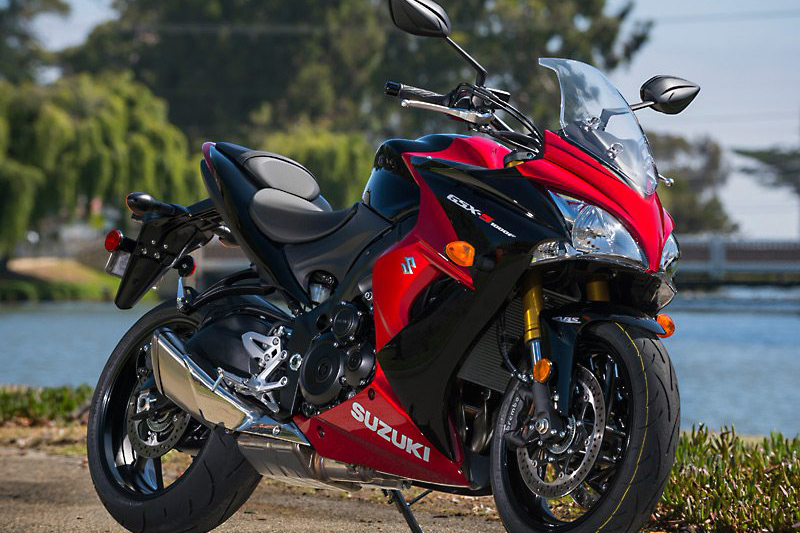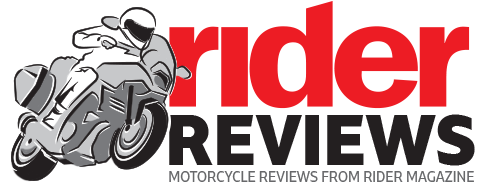2016 Suzuki GSX-S1000/F ABS

First Ride Review
Sportbikes fall into one of two categories. Track-focused sportbikes are engineered for all-out performance and make few concessions to rider comfort, with low clip-on handlebars and high, rearset pegs that make them ideal for strafing apexes but lousy for everyday riding. Street-oriented sportbikes, on the other hand, are easier to live with. Their engines are tuned for a broad spread of power and torque, sacrificing some top-end performance for grunt in the midrange where street riders spend most of their time, and their taller handlebars and lower footpegs—both positioned for less bodily contortion—permit a more upright, civilized riding position.
Not surprisingly, track-focused sportbikes are popular among young riders while street-oriented sportbikes are more popular among the young at heart. Suzuki is rolling out three versions of the latter for 2016—the naked GSX-S1000 (with or without ABS) and the faired GSX-S1000F ABS—and says they’re targeted at experienced riders over age 40, the sort of folks who can live with 145 horsepower at the crank (claimed) rather than the 185 horsepower of the GSX-R1000 K5 (2005-2008) the GSX-S is based on. They’ve got bills to pay and responsibilities to shoulder and know better than to fully wring out a liter-class sportbike on the street.
Gee, sounds a lot like me.
Suzuki chose the GSX-R1000 K5 engine for its long-stroke design (good for low to midrange power), crankshaft/gearbox layout (which allows the twin-spar frame to run straight from the steering head to the swingarm pivot) and reputation for championship-winning performance and reliability. In the GSX-S1000, the liquid-cooled 999cc in-line four gets milder cam profiles and valve timing, steel rather than titanium valves and lighter pistons. Although the GSX-S uses a traditional cable-actuated throttle, its fuel injection system features the tried-and-true Suzuki Dual Throttle Valve for smooth power delivery and optimal combustion. The exhaust, which is made of stainless steel rather than the K5’s costly (but lighter) titanium, uses the Suzuki Exhaust Tuning butterfly valve for better low-rpm running. Power is transferred through a slip-and-assist clutch to a 6-speed transmission and chain final drive.
At Suzuki’s press launch in Monterey, California, I rode both the naked GSX-S1000 ABS and the faired GSX-S1000F ABS. We logged nearly 100 miles on the naked bike in the morning, riding up the Pacific Coast into the Santa Cruz Mountains for lunch at Alice’s Restaurant, a popular motorcycle destination on Skyline Boulevard that bears no relation to the famous Arlo Guthrie song of the same name. We spent the afternoon aboard the faired GSX-S1000F ABS, enjoying the smoothly cambered curves of La Honda Road and the rugged scenery of Highway 1.
GSX-S1000 models are the first to feature the new Suzuki Easy Start System, which requires just a quick tap of the starter button. Holding down the button while the engine cranks over has never seemed laborious, but SESS works as promised, with the bonus of not having to pull in the clutch to start the bike in neutral. Another nifty feature is the multi-function LCD instrument panel, which weighs just 9.7 ounces and is packed with data. One of Suzuki’s primary goals was low weight, and the naked ABS model weighs a claimed 461 pounds with its 4.5-gallon tank full (the faired model adds another 10 pounds).
With no throttle-by-wire, there aren’t any riding modes to worry about. Just twist the throttle and savor the sweet smoothness of in-line four power, which increases steadily with revs and tops out at 145 crankshaft horsepower at 10,000 rpm, with a peak of 78 lb-ft of torque at 9,500 rpm. A few tingles find their way through the grips and pegs, but not many. This is a well-sorted, refined powerplant, one that tantalizes the rider with plenty of intake honk and exhaust howl (from a low-slung silencer that’s stylish rather than cumbersome). Detuned engines can sometimes be dull or dumbed-down, but that’s not the case with the GSX-S1000. Throttle response is instantaneous and the engine pulls smoothly and strongly almost everywhere. To keep things from getting too lively, standard traction control offers three levels of intervention or it can be turned off.
Holding everything together is an aluminum twin-spar frame that’s actually lighter than its GSX-R1000 counterpart, while the arched aluminum swingarm is taken directly from the GSX-R. And although the GSX-S has the same trail (3.9 inches) and seat height (31.9 inches) as the GSX-R, for better street manners it has more rake (25 degrees vs. 23.5) and a longer wheelbase (57.5 inches vs. 55.3). Light pressure on the bar is all that’s required to change direction, and the Dunlop Sportmax D214 tires provide good grip. KYB suspension, with a fully adjustable fork, preload/rebound adjustable shock and 4.7/5.1 inches of front/rear travel, has good compliance and just the right amount of stiffness. Up front, a pair of Brembo monoblock 4-piston radial calipers squeeze 310mm discs with conviction, but they could use more feedback. ABS, which adds just 1.4 pounds, is optional on the naked model but standard on the faired version.
These are sportbikes where comfort isn’t an afterthought. With sensibly placed footpegs and a tapered aluminum Renthal FatBar perched atop the triple clamp, the riding position is active without being ache-inducing. The rider’s seat is comfortable—flat, nicely padded and tapered in front—but the pillion is thin and small. On the naked model, windblast hits the rider forcefully but without excessive turbulence. On the faired model, airflow is even smoother and causes less fatigue on long rides, but the small windscreen is not adjustable.
Suzuki has done well with this trio of real-world sportbikes. Sure, styling doesn’t break any new ground, fuel capacity should be at least 5 gallons and Suzuki missed a golden opportunity by not offering factory accessory hard saddlebags, but these are minor quibbles. Motorcycle technology has progressed so far in the past few years and so much of the good stuff has trickled down, that mid-priced bikes can be had with high-performance (even if detuned) engines, ABS, traction control, radial-mount brakes and good tires. The Suzuki GSX-S1000F ABS offers all of the performance most of us will ever need for a very reasonable $10,999, which is $3,400 cheaper than the GSX-R1000 ABS. Losing the fairing saves $500, and going without ABS lowers the price to just $9,999.
Finally, a cure for the mid-life crisis that won’t break the bank.
